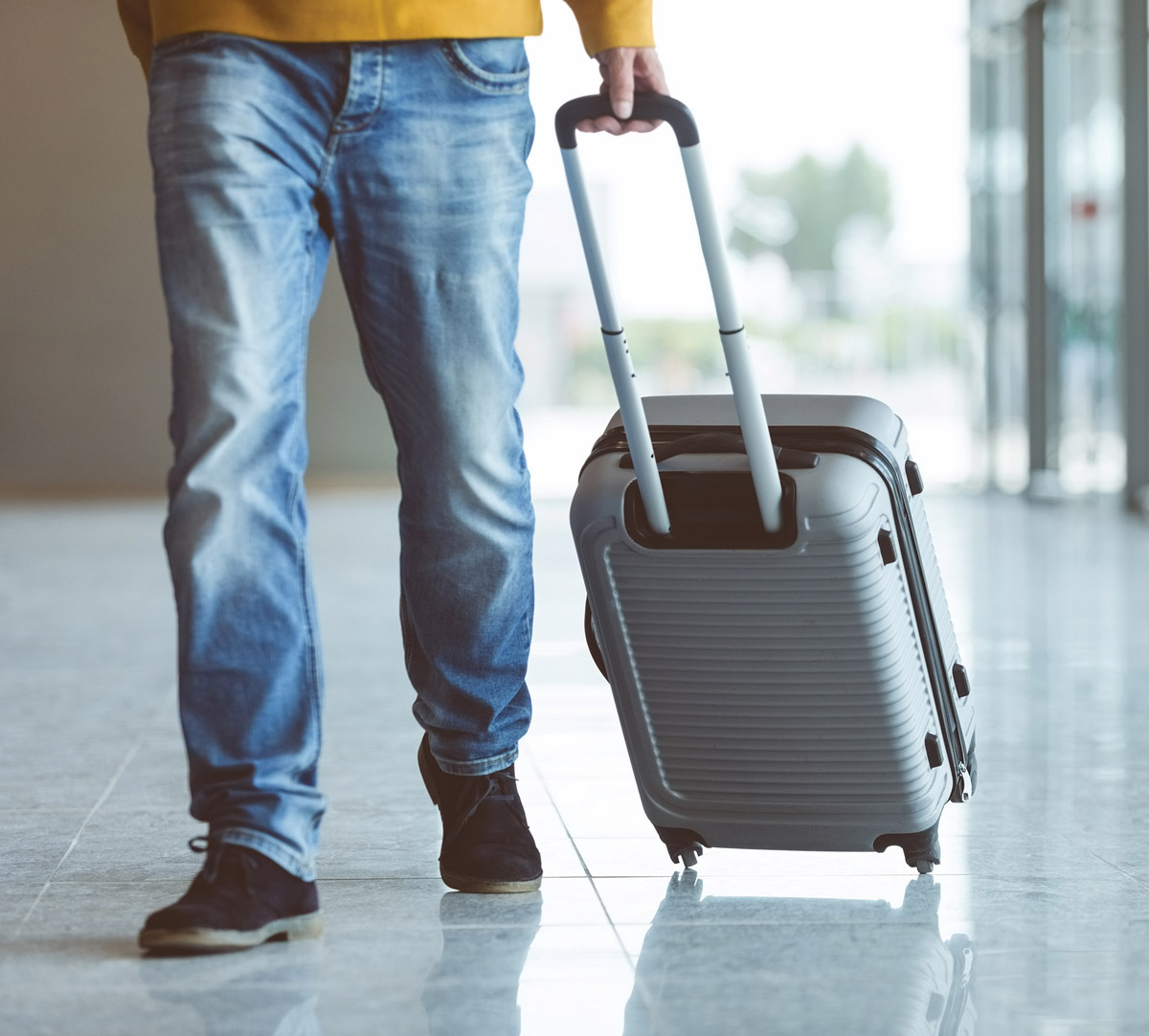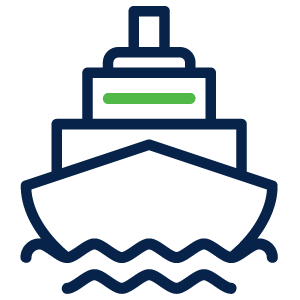Travelling with Oxygen
Just because you need home oxygen therapy does not mean you can’t travel away from home.
It does mean that you must PLAN AHEAD.

Advance Planning is Essential.
Planning in advance will lead to a worry-free enjoyable trip. Some preparation needs to happen before you even plan your trip, while other preparations should be done in the weeks leading up to your travel.
As the information we provide below is general in nature, and regulations change regularly, it is recommended that you contact your oxygen supplier, travel agent and travel carrier prior to travelling.
Tips for Travelling with Oxygen.
- Before you make any plans to travel, check with your doctor to determine that you are capable of travel and what extra precautions may be necessary.
- Have a copy(s) of your oxygen prescription, including oxygen litre flow and hours of use, with you at all times, as well as a current list of medications you are receiving. Make several copies of the prescription and medication list as you may need to present a copy to flight attendants or oxygen suppliers during your travel.
- You may also require a physician statement indicating your ability to travel, travel itinerary (general) and oxygen flow rates.
- If arranging your travel through a travel agent, be sure to inform them you will be travelling with oxygen before you book your trip.
- If arranging your travel through a travel agent, be sure to inform them you will be travelling with oxygen before you book your trip.
- Notify your oxygen supplier and of your travel plans as they may be able to assist you with your oxygen needs during your trip.
- Avoid travel travelling to, or through, locations at high elevations as these may make your breathing more difficult.
- There may be costs for oxygen when travelling that may not be covered by your government oxygen program, private health insurance or other payors.

Travelling by Plane
LEARN MORE >

Cruise Ship Travel
LEARN MORE >

Travelling By Train
LEARN MORE >

Automotive Travel
LEARN MORE >

Travel by Bus
LEARN MORE >

Travelling by Plane
The Federal Aviation Administration (FAA) regulations allow passengers to use three different types of portable oxygen concentrators on board commercial aircraft. Check with each airline to determine, which system they allow.
- Notify the airline when booking your flight that you are on oxygen and may require oxygen during the flight. Each airline will have specific information they require prior to travel.
- Most airlines will allow portable oxygen concentrators on board while others will require you use their oxygen systems – there will likely be charges attached to using airline oxygen.
- If travelling with portable oxygen concentrators, ensure you have extra batteries for your flight. Some airlines may have outlets at your seat that allow you to plug in your unit, but many will not.
- Fly non-stop if possible. This eliminates the hassle of arranging oxygen deliveries to the airport which results in extra charges.
- Notify the airline of any other special needs prior to travel (wheelchair, motorized carts etc.).
- Reconfirm your travel plans with the airline at least 72 hours in advance.
Important Information Regarding Security Screening of Portable Oxygen Concentrators (POC’s)
According to Transport Canada and the U.S. Department of Homeland Screening, POC’s are allowed through security checkpoints once they have been screened.
Other disability and medically related items permitted beyond the checkpoint include, but are not limited to wheelchairs, scooters, medications and associated supplies and CPAP units.
- Arrive 2-3 hours prior to your scheduled departure.
- Follow all published rules regarding carry on items and medications.
- Bring documentation on medications, devices, medical condition where possible. This is not a requirement and will not exempt a passenger from the screening process.
- Pack medications in a clear bag separate from other carry-on items/bags.
- Ensure medically prescribed medication bottles (name on bottle) matches your ticket.
- Exercise patience with lines, delays, and stringent screening procedures.

Cruise Ship Travel
Arranging for oxygen therapy while on a cruise requires advance planning. Many cruise lines will provide oxygen onboard while others will allow you to bring your own. These arrangements should be made at least 30 – 45 days prior to your travel.
- Ask your travel agent if there are any special requirements when travelling with oxygen. Most cruise lines specify each passenger must make his or her own oxygen arrangements. Your oxygen supplier can help you with coordinating oxygen for your trip. Passengers must provide a letter from their doctor prior to travel indicating they are fit to travel, travel plans and oxygen prescription (hours of use and oxygen flowrate).
- When coordinating your oxygen needs for your cruise you will need to provide the following information:
- Name of Cruise line and vessel
- Departure city and date as well as return city and date.
- Oxygen flow rate and hours of use
- Equipment needs will be determined based on the information you provide so be as accurate as possible.
- Once oxygen has been arranged it will be delivered to the vessel on the day of your departure. Ships do not refill oxygen tanks.
- Costs for oxygen on cruise lines may not be covered by government programs, private insurance carriers or other payors.

Travelling By Train
Some train lines allow you to bring portable oxygen on board however contact the train line far in advance of your trip to plan accordingly.
VIA Rail
- VIA Rail allows you to take a maximum of one oxygen tank with you. You are also allowed to use your oxygen concentrator (portable or stationary) on your trip.
- It is suggested you bring a short extension cord as well.
- Please notify VIA Rail at the time of booking that you will be travelling with oxygen.
Amtrak
- Notify Amtrak at least 24 hours prior to travelling.
- Oxygen on board cannot exceed one double tank set up of 75 pounds. You must be able to separate the tanks and they cannot be on wheels. A six-tank set up is allowed so long as each tank is less than 20 pounds.
- Equipment requiring electrical power must be self-contained (battery) for trips less than 12 hours. Electrical power on the train may be used for trips greater than 12 hours.
- Carry additional oxygen in the event of travel delays.
- Reserve a private compartment if possible.
Contact Amtrak: 1-800-872-7245

Automotive Travel
When travelling by automobile, advance planning makes the journey far more enjoyable. As you map your route, consider the following:
-
- Length of trip
- Number of overnight stops
- Distance between each scheduled stop
- Oxygen prescription and hours of use (helps determine number of cylinders required if not using a portable oxygen concentrator)
- Your oxygen supplier may be able to assist you with contacts for oxygen refills along your route. Schedule your trip to take advantage of oxygen exchange or refill points. This decreases the number of cylinders you may need to carry in your vehicle.
- Always carry enough back up oxygen to deal with unexpected travel delays (road work, bad road conditions etc).
- When traveling through high elevations or mountain passes you may require more oxygen than you do when at home. Try and avoid travelling to high elevations whenever possible.
- Secure your oxygen equipment in the car and whenever possible do not store oxygen cylinders in your trunk.
- Portable oxygen concentrators can be used with most vehicle car lighter adapters or internal batteries decreasing the number of compressed oxygen cylinders required or eliminating the need for liquid oxygen reservoirs.

Travel by Bus
Most bus lines will allow passengers to carry portable oxygen and portable oxygen concentrators. If travelling by bus in Canada, or as part of your international travel plans, it is important to contact the bus company far in advance to determine their requirements for oxygen on board.
- There may be limits related to the number, size or weight of oxygen tanks you can carry on so be sure to learn the rules from the bus line you are using.
- Bring a medical release from your doctor. You may also need a prescription that lists the flow rate and amount of oxygen you use.
- If planning a multi-day journey by bus, make sure the bus stops at cities where you can get your tanks refilled if needed.
Regardless of how you plan to travel, our respiratory care experts can help you remain on oxygen therapy while away from home.
Sleep better. Breathe better. Live better.
Your Sleep Apnea Diagnostics and Treatment Professionals
Accredited by the BC College of Physicians and the College of Physicians and Surgeons of Alberta
Celebrating 25 Years of Excellence in Respiratory Care

Trusted Health Professionals.
25 Convenient Locations.
Toll Free Support.
With clinics in communities across BC, Alberta and Ontario, we are here when and where you need us.
Call, email or message us. We’re here to help!